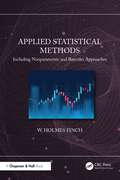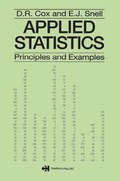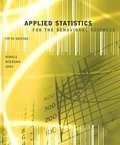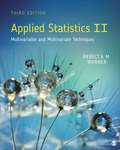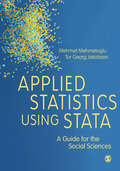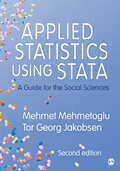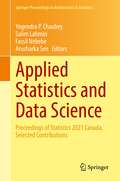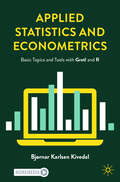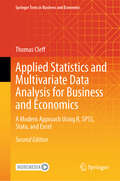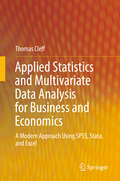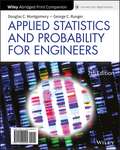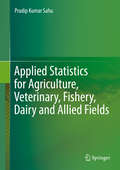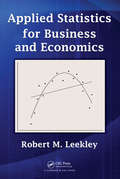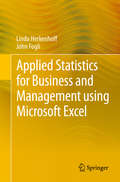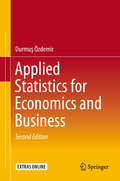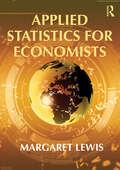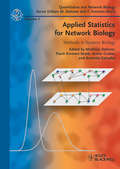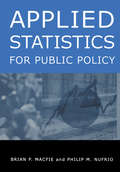- Table View
- List View
Applied Statistical Methods: Including Nonparametric and Bayesian Approaches
by W. Holmes FinchThis book is designed to provide students, teachers, and researchers with a text that includes a full range of statistical methods available to address commonly encountered research problems. Many textbooks for introductory, intermediate, and advanced statistics courses focus heavily on parametric methods. However, in practice, the assumptions underlying these methods are frequently not met, therefore calling into question their use. This book addresses this issue by presenting parametric, nonparametric, robust, and Bayesian techniques that are appropriate for research scenarios often encountered in practice and typically found in statistics courses. For each of these major topics, the standard parametric approach is presented, along with the assumptions underlying it and the methods used to assess the viability of these assumptions. Next, a set of alternative techniques for the research scenario is presented and applied to the motivating example that begins each chapter. Each chapter concludes with a summary focused on how researchers should select which method to use when and a summary of the material covered in the chapter. The chapters have motivating examples that serve as an anchor for discussion of the featured methods. The focus of the chapters is intended to be conceptual (as opposed to highly technical) to make the text useful to individuals with a wide array of statistical backgrounds. More technical material is included in each chapter for interested readers and instructors who would like to focus more attention on it. Instructors will be able to use this book as a main text in introductory, intermediate, and some specialized statistics courses such as nonparametric and robust methods. In addition, researchers and data analysts from a wide array of disciplines will be able to use this book as a primary resource in their work.Key features of this book are as follows: It presents a full range of statistical options available to researchers for major problems faced in the social and life sciences, health care, and business. It explains how to evaluate a dataset to determine which statistical approach (e.g., standard parametric, nonparametric, robust, Bayesian) may be optimal. It features a website containing datasets and computer code.
Applied Statistics - Principles and Examples
by D.R. CoxThis book should be of interest to senior undergraduate and postgraduate students of applied statistics.
Applied Statistics For The Behavioral Sciences
by William Wiersma Stephen G. Jurs Dennis E. HinkleThis introductory text provides students with a conceptual understanding of basic statistical procedures, as well as the computational skills needed to complete them. The clear presentation, accessible language, and step-by-step instruction make it easy for students from a variety of social science disciplines to grasp the material. The scenarios presented in chapter exercises span the curriculum, from political science to marketing, so that students make a connection between their own area of interest and the study of statistics. Unique coverage focuses on concepts critical to understanding current statistical research such as power and sample size, multiple comparison tests, multiple regression, and analysis of covariance. Additional SPSS coverage throughout the text includes computer printouts and expanded discussion of their contents in interpreting the results of sample exercises.
Applied Statistics I: Basic Bivariate Techniques
by Rebecca M. WarnerRebecca M. Warner’s bestselling Applied Statistics: From Bivariate Through Multivariate Techniques has been split into two volumes for ease of use over a two-course sequence. Applied Statistics I: Basic Bivariate Techniques, Third Edition is an introductory statistics text based on chapters from the first half of the original book. The author's contemporary approach reflects current thinking in the field, with its coverage of the "new statistics" and reproducibility in research. Her in-depth presentation of introductory statistics follows a consistent chapter format, includes some simple hand-calculations along with detailed instructions for SPSS, and helps students understand statistics in the context of real-world research through interesting examples. Datasets are provided on an accompanying website.
Applied Statistics I: Basic Bivariate Techniques
by Rebecca M. WarnerRebecca M. Warner&’s bestselling Applied Statistics: From Bivariate Through Multivariate Techniques has been split into two volumes for ease of use over a two-course sequence. Applied Statistics I: Basic Bivariate Techniques, Third Edition is an introductory statistics text based on chapters from the first half of the original book. The author's contemporary approach reflects current thinking in the field, with its coverage of the "new statistics" and reproducibility in research. Her in-depth presentation of introductory statistics follows a consistent chapter format, includes some simple hand-calculations along with detailed instructions for SPSS, and helps students understand statistics in the context of real-world research through interesting examples. Datasets are provided on an accompanying website.
Applied Statistics II: Multivariable and Multivariate Techniques
by Rebecca M. WarnerRebecca M. Warner&’s bestselling Applied Statistics: From Bivariate Through Multivariate Techniques has been split into two volumes for ease of use over a two-course sequence. Applied Statistics II: Multivariable and Multivariate Techniques, Third Edition is a core multivariate statistics text based on chapters from the second half of the original book. The text begins with two new chapters: an introduction to the new statistics, and a chapter on handling outliers and missing values. All chapters on statistical control and multivariable or multivariate analyses from the previous edition are retained (with the moderation chapter heavily revised) and new chapters have been added on structural equation modeling, repeated measures, and on additional statistical techniques. Each chapter includes a complete example, and begins by considering the types of research questions that chapter&’s technique can answer, progresses to data screening, and provides screen shots of SPSS menu selections and output, and concludes with sample results sections. By-hand computation is used, where possible, to show how elements of the output are related to each other, and to obtain confidence interval and effect size information when SPSS does not provide this. Datasets are available on the accompanying website.
Applied Statistics II: Multivariable and Multivariate Techniques
by Rebecca M. WarnerRebecca M. Warner&’s bestselling Applied Statistics: From Bivariate Through Multivariate Techniques has been split into two volumes for ease of use over a two-course sequence. Applied Statistics II: Multivariable and Multivariate Techniques, Third Edition is a core multivariate statistics text based on chapters from the second half of the original book. The text begins with two new chapters: an introduction to the new statistics, and a chapter on handling outliers and missing values. All chapters on statistical control and multivariable or multivariate analyses from the previous edition are retained (with the moderation chapter heavily revised) and new chapters have been added on structural equation modeling, repeated measures, and on additional statistical techniques. Each chapter includes a complete example, and begins by considering the types of research questions that chapter&’s technique can answer, progresses to data screening, and provides screen shots of SPSS menu selections and output, and concludes with sample results sections. By-hand computation is used, where possible, to show how elements of the output are related to each other, and to obtain confidence interval and effect size information when SPSS does not provide this. Datasets are available on the accompanying website.
Applied Statistics Using R: A Guide for the Social Sciences
by Mehmet Mehmetoglu Matthias MittnerIf you want to learn to use R for data analysis but aren’t sure how to get started, this practical book will help you find the right path through your data. Drawing on real-world data to show you how to use different techniques in practice, it helps you progress your programming and statistics knowledge so you can apply the most appropriate tools in your research. It starts with descriptive statistics and moves through regression to advanced techniques such as structural equation modelling and Bayesian statistics, all with digestible mathematical detail for beginner researchers. The book: Shows you how to use R packages and apply functions, adjusting them to suit different datasets. Gives you the tools to try new statistical techniques and empowers you to become confident using them. Encourages you to learn by doing when running and adapting the authors’ own code. Equips you with solutions to overcome the potential challenges of working with real data that may be messy or imperfect. Accompanied by online resources including screencast tutorials of R that give you step by step guidance and R scripts and datasets for you to practice with, this book is a perfect companion for any student of applied statistics or quantitative research methods courses.
Applied Statistics Using R: A Guide for the Social Sciences
by Mehmet Mehmetoglu Matthias MittnerIf you want to learn to use R for data analysis but aren’t sure how to get started, this practical book will help you find the right path through your data. Drawing on real-world data to show you how to use different techniques in practice, it helps you progress your programming and statistics knowledge so you can apply the most appropriate tools in your research. It starts with descriptive statistics and moves through regression to advanced techniques such as structural equation modelling and Bayesian statistics, all with digestible mathematical detail for beginner researchers. The book: Shows you how to use R packages and apply functions, adjusting them to suit different datasets. Gives you the tools to try new statistical techniques and empowers you to become confident using them. Encourages you to learn by doing when running and adapting the authors’ own code. Equips you with solutions to overcome the potential challenges of working with real data that may be messy or imperfect. Accompanied by online resources including screencast tutorials of R that give you step by step guidance and R scripts and datasets for you to practice with, this book is a perfect companion for any student of applied statistics or quantitative research methods courses.
Applied Statistics Using Stata: A Guide for the Social Sciences
by Mehmet Mehmetoglu Tor Georg JakobsenClear, intuitive and written with the social science student in mind, this book represents the ideal combination of statistical theory and practice. It focuses on questions that can be answered using statistics and addresses common themes and problems in a straightforward, easy-to-follow manner. The book carefully combines the conceptual aspects of statistics with detailed technical advice providing both the ‘why’ of statistics and the ‘how’. Built upon a variety of engaging examples from across the social sciences it provides a rich collection of statistical methods and models. Students are encouraged to see the impact of theory whilst simultaneously learning how to manipulate software to meet their needs. The book also provides: Original case studies and data sets Practical guidance on how to run and test models in Stata Downloadable Stata programmes created to work alongside chapters A wide range of detailed applications using Stata Step-by-step notes on writing the relevant code. This excellent text will give anyone doing statistical research in the social sciences the theoretical, technical and applied knowledge needed to succeed.
Applied Statistics Using Stata: A Guide for the Social Sciences
by Mehmet Mehmetoglu Tor Georg JakobsenClear, intuitive and written with the social science student in mind, this book represents the ideal combination of statistical theory and practice. It focuses on questions that can be answered using statistics and addresses common themes and problems in a straightforward, easy-to-follow manner. The book carefully combines the conceptual aspects of statistics with detailed technical advice providing both the ‘why’ of statistics and the ‘how’. Built upon a variety of engaging examples from across the social sciences it provides a rich collection of statistical methods and models. Students are encouraged to see the impact of theory whilst simultaneously learning how to manipulate software to meet their needs. The book also provides: Original case studies and data sets Practical guidance on how to run and test models in Stata Downloadable Stata programmes created to work alongside chapters A wide range of detailed applications using Stata Step-by-step notes on writing the relevant code. This excellent text will give anyone doing statistical research in the social sciences the theoretical, technical and applied knowledge needed to succeed.
Applied Statistics Using Stata: A Guide for the Social Sciences
by Mehmet Mehmetoglu Tor Georg JakobsenStraightforward, clear, and applied, this book will give you the theoretical and practical basis you need to apply data analysis techniques to real data. Combining key statistical concepts with detailed technical advice, it addresses common themes and problems presented by real research, and shows you how to adjust your techniques and apply your statistical knowledge to a range of datasets. It also embeds code and software output throughout and is supported by online resources to enable practice and safe experimentation. The book includes: · Original case studies and data sets · Practical exercises and lists of commands for each chapter · Downloadable Stata programmes created to work alongside chapters · A wide range of detailed applications using Stata · Step-by-step guidance on writing the relevant code. This is the perfect text for anyone doing statistical research in the social sciences getting started using Stata for data analysis.
Applied Statistics Using Stata: A Guide for the Social Sciences
by Mehmet Mehmetoglu Tor Georg JakobsenStraightforward, clear, and applied, this book will give you the theoretical and practical basis you need to apply data analysis techniques to real data. Combining key statistical concepts with detailed technical advice, it addresses common themes and problems presented by real research, and shows you how to adjust your techniques and apply your statistical knowledge to a range of datasets. It also embeds code and software output throughout and is supported by online resources to enable practice and safe experimentation. The book includes: · Original case studies and data sets · Practical exercises and lists of commands for each chapter · Downloadable Stata programmes created to work alongside chapters · A wide range of detailed applications using Stata · Step-by-step guidance on writing the relevant code. This is the perfect text for anyone doing statistical research in the social sciences getting started using Stata for data analysis.
Applied Statistics and Data Science: Proceedings of Statistics 2021 Canada, Selected Contributions (Springer Proceedings in Mathematics & Statistics #375)
by Yogendra P. Chaubey Salim Lahmiri Fassil Nebebe Arusharka SenThis proceedings volume features top contributions in modern statistical methods from Statistics 2021 Canada, the 6th Annual Canadian Conference in Applied Statistics, held virtually on July 15-18, 2021. Papers are contributed from established and emerging scholars, covering cutting-edge and contemporary innovative techniques in statistics and data science. Major areas of contribution include Bayesian statistics; computational statistics; data science; semi-parametric regression; and stochastic methods in biology, crop science, ecology and engineering. It will be a valuable edited collection for graduate students, researchers, and practitioners in a wide array of applied statistical and data science methods.
Applied Statistics and Econometrics: Basic Topics and Tools with Gretl and R
by Bjørnar Karlsen KivedalThis accessible textbook introduces the foundations of applied econometrics and statistics for undergraduate students. It covers key topics in econometrics by using step-by-step examples in Gretl and R, providing a guide to using statistical software and the tools for econometric analysis in one self-contained resource. Taking a concise, non-technical approach, the book covers topics including simple regression and hypothesis testing, multiple regression with control variables and isolating effects, instrumental variables, dummy variables, non-linear effects, probability models, heteroskedasticity, time series analysis, and other applied statistical tools such as t-tests and chi squared tests. The book uses small data sets to easily facilitate students’ transition from manual statistical calculations to using and understanding statistical software, including step-by-step examples of regression analysis, as well as additional chapters to aid with econometric notation and mathematical prerequisites, and accompanying online exercises and data sets. This book will be a valuable resource for upper undergraduate students taking courses in introductory econometrics and statistics, as well as students in business administration and other fields of study in social sciences utilising quantitative methods. Graduate students may also benefit from the book.
Applied Statistics and Multivariate Data Analysis for Business and Economics: A Modern Approach Using R, SPSS, Stata, and Excel (Springer Texts in Business and Economics)
by Thomas CleffThis comprehensive textbook equips students of economics and business, as well as industry professionals, with essential principles, techniques, and applications of applied statistics, statistical testing, and multivariate data analysis. Through real-world business examples, it illustrates the practical use of univariate, bivariate, and multivariate statistical methods. The content spans a broad range of topics, from data collection and scaling to the presentation and fundamental univariate analysis of quantitative data, while also demonstrating advanced analytical techniques for exploring multivariate relationships. The book systematically covers all topics typically included in university-level courses on statistics and advanced applied data analysis. Beyond theoretical discussion, it offers hands-on guidance for using statistical software tools such as Excel, SPSS, Stata, and R. In this completely revised and updated second edition, new sections on logistic regression are included, along with enhanced examples and solutions using R for all covered statistical methods. This edition provides a robust resource for mastering applied statistics in both academic and professional settings.
Applied Statistics and Multivariate Data Analysis for Business and Economics: A Modern Approach Using SPSS, Stata, and Excel
by Thomas CleffThis textbook will familiarize students in economics and business, as well as practitioners, with the basic principles, techniques, and applications of applied statistics, statistical testing, and multivariate data analysis. Drawing on practical examples from the business world, it demonstrates the methods of univariate, bivariate, and multivariate statistical analysis. The textbook covers a range of topics, from data collection and scaling to the presentation and simple univariate analysis of quantitative data, while also providing advanced analytical procedures for assessing multivariate relationships. Accordingly, it addresses all topics typically covered in university courses on statistics and advanced applied data analysis. In addition, it does not limit itself to presenting applied methods, but also discusses the related use of Excel, SPSS, and Stata.
Applied Statistics and Probability for Engineers
by Douglas C. Montgomery George C. RungerApplied Statistics and Probability for Engineers provides a practical approach to probability and statistical methods. Students learn how the material will be relevant in their careers by including a rich collection of examples and problem sets that reflect realistic applications and situations. This product focuses on real engineering applications and real engineering solutions while including material on the bootstrap, increased emphasis on the use of p-value, coverage of equivalence testing, and combining p-values. The base content, examples, exercises and answers presented in this product have been meticulously checked for accuracy.
Applied Statistics for Agriculture, Veterinary, Fishery, Dairy and Allied Fields
by Pradip Kumar SahuThis book is aimed at a wide range of readers who lack confidence in the mathematical and statistical sciences, particularly in the fields of Agriculture, Veterinary, Fishery, Dairy and other related areas. Its goal is to present the subject of statistics and its useful tools in various disciplines in such a manner that, after reading the book, readers will be equipped to apply the statistical tools to extract otherwise hidden information from their data sets with confidence. Starting with the meaning of statistics, the book introduces measures of central tendency, dispersion, association, sampling methods, probability, inference, designs of experiments and many other subjects of interest in a step-by-step and lucid manner. The relevant theories are described in detail, followed by a broad range of real-world worked-out examples, solved either manually or with the help of statistical packages. In closing, the book also includes a chapter on which statistical packages to use, depending on the user's respective requirements.
Applied Statistics for Business and Economics
by Robert M. LeekleyDesigned for a one-semester course, Applied Statistics for Business and Economics offers students in business and the social sciences an effective introduction to some of the most basic and powerful techniques available for understanding their world. Numerous interesting and important examples reflect real-life situations, stimulating students to t
Applied Statistics for Business and Management using Microsoft Excel
by Linda Herkenhoff John FogliApplied Business Statistics for Business and Management using Microsoft Excel is the first book to illustrate the capabilities of Microsoft Excel to teach applied statistics effectively. It is a step-by-step exercise-driven guide for students and practitioners who need to master Excel to solve practical statistical problems in industry. If understanding statistics isn't your strongest suit, you are not especially mathematically-inclined, or if you are wary of computers, this is the right book for you. Excel, a widely available computer program for students and managers, is also an effective teaching and learning tool for quantitative analyses in statistics courses. Its powerful computational ability and graphical functions make learning statistics much easier than in years past. However, Applied Business Statistics for Business and Management capitalizes on these improvements by teaching students and practitioners how to apply Excel to statistical techniques necessary in their courses and workplace. Each chapter explains statistical formulas and directs the reader to use Excel commands to solve specific, easy-to-understand business problems. Practice problems are provided at the end of each chapter with their solutions.
Applied Statistics for Economics and Business
by Durmuş ÖzdemirThis textbook introduces readers to practical statisticalissues by presenting them within the context of real-life economics andbusiness situations. It presents the subject in a non-threatening manner, withan emphasis on concise, easily understandable explanations. It has beendesigned to be accessible and student-friendly and, as an added learningfeature, provides all the relevant data required to complete the accompanyingexercises and computing problems, which are presented at the end of eachchapter. It also discusses index numbers and inequality indices in detail,since these are of particular importance to students and commonly omitted intextbooks. Throughout the text it is assumed that the student has noprior knowledge of statistics. It is aimed primarily at business and economicsundergraduates, providing them with the basic statistical skills necessary forfurther study of their subject. However, students of other disciplines willalso find it relevant.
Applied Statistics for Economists
by Margaret LewisThis book is an undergraduate text that introduces students to commonly-used statistical methods in economics. Using examples based on contemporary economic issues and readily-available data, it not only explains the mechanics of the various methods, it also guides students to connect statistical results to detailed economic interpretations. Because the goal is for students to be able to apply the statistical methods presented, online sources for economic data and directions for performing each task in Excel are also included.
Applied Statistics for Network Biology: Methods in Systems Biology (Quantitative and Network Biology (VCH) #5)
by Matthias Dehmer Frank Emmert-Streib Armindo Salvador Armin GraberThe book introduces to the reader a number of cutting edge statistical methods which can e used for the analysis of genomic, proteomic and metabolomic data sets. In particular in the field of systems biology, researchers are trying to analyze as many data as possible in a given biological system (such as a cell or an organ). The appropriate statistical evaluation of these large scale data is critical for the correct interpretation and different experimental approaches require different approaches for the statistical analysis of these data. This book is written by biostatisticians and mathematicians but aimed as a valuable guide for the experimental researcher as well computational biologists who often lack an appropriate background in statistical analysis.
Applied Statistics for Public Policy
by Brian P. Macfie Philip M. NufrioThis practical text provides students with the statistical tools needed to analyze data, and shows how statistics can be used as a tool in making informed, intelligent policy decisions. The authors' approach helps students learn what statistical measures mean and focus on interpreting results, as opposed to memorizing and applying dozens of statistical formulae. The book includes more than 500 end-of-chapter problems, solvable with the easy-to-use Excel spreadsheet application developed by the authors. This template allows students to enter numbers into the appropriate sheet, sit back, and analyze the data. This comprehensive, hands-on textbook requires only a background in high school algebra and has been thoroughly classroom-tested in both undergraduate and graduate level courses. No prior expertise with Excel is required. A disk with the Excel template and the data sets is included with the book, and solutions to the end-of-chapter problems will be provided on the M.E. Sharpe website.
